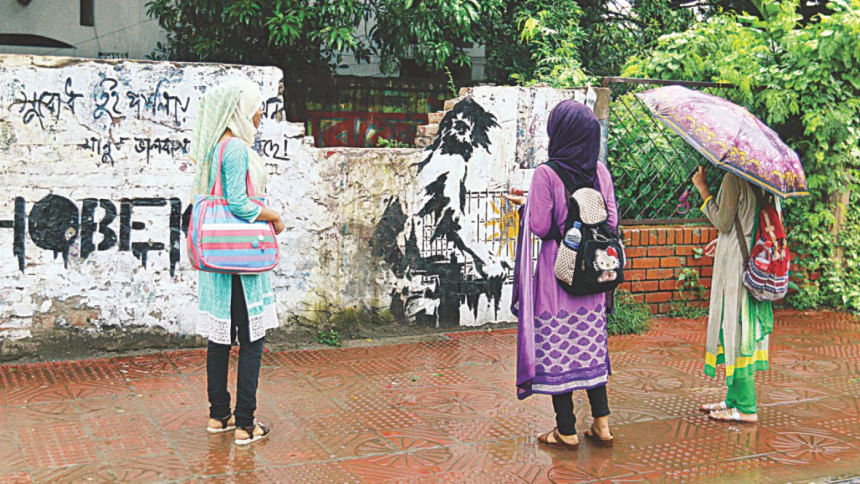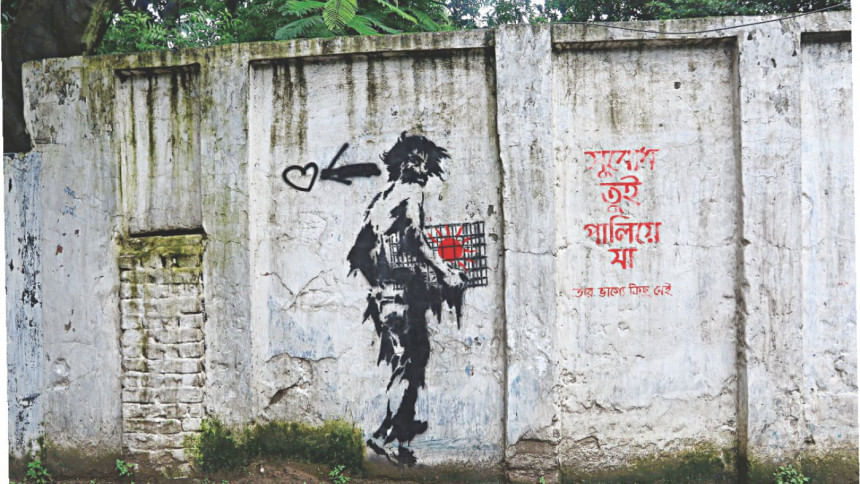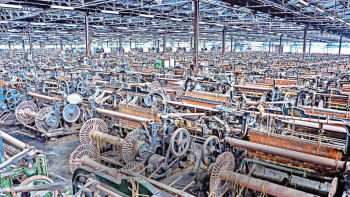SUBODH'S sorrow and our tomorrow

If you find a group of pedestrians staring, transfixed by a subtle yet imposing graffiti on a wall, don't be surprised. In parts of Dhaka, there has been a sudden appearance of a graffiti. Instead of going down the revolutionary road, in simply worded messages, the art work only asks viewers for introspection. It urges its own protagonist, a character called Subodh, to run away.
Subodh's silhouette appears in increasingly haggard conditions. At first glance, he is just an ordinary man whose good senses may be at conflict with his settings. Look deeper and a richer narrative unfolds. Subodh's hair is disheveled, his clothes are torn; one can be forgiven for glimpsing just a hint of hopelessness in his cold, black eyes. But this is just one part of what appears to be a series of graffiti, striving to tell a story no one wants to comfortably hear.
While the graffiti artist, faceless likes their creation, is touted as the Banksy of Bangladesh, the comparison can be a bit of a disservice to him or her. Unlike Banksy, there is nothing satirical about the individual's work. The method may be similar but the point being made is open to many interpretations. All the works seen are stenciled but they are almost like anti-epigrams. More importantly, Subodh's creator does not benefit from the comfort of protection offered in so-called first world countries.
In one instance, on a canvas of a white wall, Subodh's image appears, unclean and unshaven, with one simple message: “Subodh please run away. Time is not on your side. Humans have forgotten how to love.” Is Subodh yet another victim of communal violence so persistent in the country? Or he is more than that; a dark but true depiction of the people of Bangladesh fast running out of empathy?

Taken separately, the graffiti can mean many things. But Subodh's visual journey has been appearing on walls across the city and collectively, they tell a hopeless story without following any particular timeline. Subodh's tale is disparately strewn about. It has no particular beginning and only the promise of a heart-breaking end. Piecing it together is a task impossible if one were to look for a sequence. Subodh has no sequence. There is no pattern. There is just randomness captured not in grotesque chaos but a maddening simplicity.
Sometimes Subodh is seen staring into the souls of passersby, his struggle muted, like of so many others that we see on the street. He is running, constantly evading demons, except perhaps his demons are his only companions.
Move further and another graffiti shows a sun captured in a bird cell; is it the golden sun of our golden land, once promised and now bound and imprisoned? In one inscription, Subodh finds himself behind bars. The artists emphasise that his predicament evokes a sense of guilt in people's hearts. But which people? Is it us in Bangladesh? Or is it every one of us in every corner of the world?
Discarding obvious politically-charged inflections, the artist rather resorts to add symbols of power to his work. The jail cell is one such symbol. The design is intentionally minimalistic. It is also a telling commentary on Article 57 which states any post, image, or video on an electronic format that “causes to deteriorate law and order, prejudice the image of the state or person or hurt religious beliefs” are non-bailable offences. The artist thus opts to speak using nothing “inciteful” but everything insightful. The only subversion here is the utter hopeless submission.
"The people want the fall of the regime. It's your turn, doctor," a reference to Bashar Al Assad, a former ophthalmologist; these simple words, spray-painted on the wall of a school in Daraa, a small city in southwestern Syria would have quite an impact.

The Assad government's response to this harmless act of vandalism was to arrest the 15 school goers held responsible and torture them for their involvement and the first rumblings of a civil uprising began to brew. In Daraa, they called the 15 children the sons of freedom.
The Berlin Wall is another location famous for its graffiti. While the westside of the wall was etched with artwork promoting unity, the eastside was blank. When the wall came down, people claimed that graffiti had won; another demonstration of its power.
The walls of Dhaka, like the Berlin Wall, may be on their way to becoming the next biggest canvas in the world.
In Bangladesh, graffiti has been around since before independence. The walls of Dhaka University are testament to its enduring legacy.
As democratic spaces are invariably invaded, every area transforms into a canvass, a podium or a classroom. Every act of self-determination becomes one of defiance.
Subodh can be a wakeup call. Or he can be a trend shared, liked and forgotten. Will we save Subodh?
Today, there are already whispers of a course of action being planned against the artist. The question should be why? Which power structure does this graffiti threaten?
In a country that not only restricts but actively suppresses freedom of speech, we are all Subodhs and we are all Subodh's creator: only in anonymity can we speak from the heart.
“We scared of almost everything, afraid to even tell the truth. So scared of what you think of me, I'm scared of even telling you. Sometimes I'm like the only person I feel safe to tell it to. I'm locked inside a cell in me, I know that there's a jail in you….”
--- LUPE FIASCO, WORDS I NEVER SAID


 For all latest news, follow The Daily Star's Google News channel.
For all latest news, follow The Daily Star's Google News channel. 



Comments